
Devil Demons & Satan
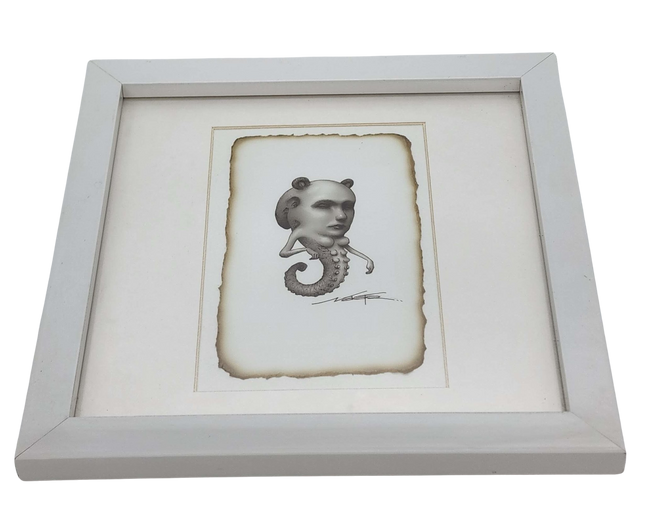
Naoto Hattori Tripping Devil Original Graphite Pencil Drawing by Naoto Hattori
Tripping Devil is an original hand-drawn art drawing on framed, hand-deckled, aged art paper by Surreal Artist Naoto Hattori. 2012 Signed Original One of a Kind Pencil/Graphite Drawing Framed Artwork Frame Size 8.5x8.5 Image Size 3x5 Custom Framed & Matted By Artist. The Fusion of Street Pop and Graffiti Art in Naoto Hattori's Work The intersection of street pop art and graffiti represents a vibrant and often rebellious art form that seeks to challenge traditional aesthetics, present social commentary, and engage public spaces as a canvas for expression. Naoto Hattori's "Tripping Devil" is a profound example of this artistic intersection, although it differs from the conventional spray-painted murals on city walls. This 2012 original pencil/graphite drawing is a testament to the diverse techniques and materials employed within the genre, bridging the raw spirit of street art with the meticulous skills of classical drawing. Hattori's piece is delicately framed, sized at 8.5x8.5 inches, with the image measuring 3x5 inches. The artist crafted the custom frame and matting, underscoring the personalized touch and attention to detail that Hattori brings to his work. The art paper is hand-deckled and aged, a choice that lends an additional layer of texture and a sense of historical depth to the piece. This material selection is particularly poignant, as it imbues the artwork with an ancient quality that contrasts sharply with the typically ephemeral nature of street and graffiti art. Naoto Hattori's Unique Aesthetic within Street Pop Art Naoto Hattori's oeuvre is often characterized by dream-like surrealism, where fantastical creatures and morphed figures challenge the viewer's perception of reality. "Tripping Devil" is no exception. The drawing features a creature with a human-like face and a body that transitions into an octopus-like form. This blending of the human and the surreal is a hallmark of Hattori's style and speaks to the transformative potential of street pop art and graffiti artwork. The stark monochromatic palette of graphite focuses on the intricate details and shading that bring the "Tripping Devil" to life. Despite being contained within a frame, the artwork carries the spirit of street pop art, often characterized by a bold defiance of boundaries and an embrace of the unconventional. Hattori's systematic approach to drawing parallels the deliberate and thoughtful techniques used by street artists and graffiti writers to create their pieces, albeit on a different scale and medium. Naoto Hattori and the Collectibility of Street Pop Art Collectors and enthusiasts of street pop art and graffiti artwork are increasingly seeking pieces to be displayed within the home, transitioning from public spectacle to personal treasure. Hattori's "Tripping Devil" exemplifies this trend, offering the art market a one-of-a-kind piece that encapsulates the essence of street art in a form that is both collectible and suited for private exhibition. The artist's signature on the piece is a seal of authenticity and a bridge between the artist and the collector. The originality of the "Tripping Devil" is paramount. In a domain where mass production and replication are commonplace, Hattori's commitment to creating a singular original work elevates the piece's value and appeal. The meticulous nature of the work, combined with its unique presentation on aged art paper, creates a dialogue between the transient nature of street art and the enduring quality of fine art collecting. The Cultural Relevance of Hattori's Artistry In the broader context of street pop art and graffiti artwork, Hattori's "Tripping Devil" stands out as a cultural artifact that embodies the innovative spirit of these art forms. While street pop art often conveys messages about popular culture and societal issues, Hattori's work delves into the psyche, exploring themes of identity, consciousness, and the human condition through a surrealistic lens. This piece, while not displayed in a public space, continues the tradition of street pop art and graffiti artwork with its aim to provoke thought and evoke emotion. The surreal elements invite interpretation and reflection, much like the larger-than-life murals and tags in urban environments. Hattori's "Tripping Devil" is a reminder that the heart of street art lies not only in its location but also in its ability to connect with viewers on a profound level, challenging perceptions and encouraging a deeper engagement with the visual narrative. Naoto Hattori's "Tripping Devil" is an exquisite example of the potential for cross-pollination between street pop art, graffiti artwork, and traditional drawing techniques. It stands as a testament to the artist's skill and the versatility of street-inspired art. As this piece demonstrates, the value of street pop art and graffiti artwork extends beyond the city's walls, finding a place within the collections of art lovers who appreciate the nuanced blend of rebellion, craftsmanship, and narrative depth that these genres offer.
$771.00
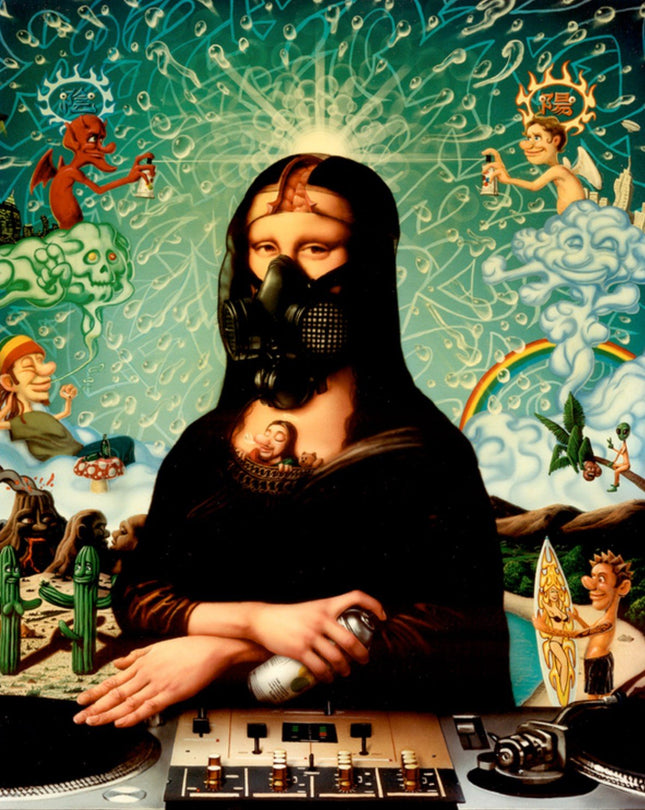
Naoto Hattori Sweet Dreams Giclee Print by Naoto Hattori
Sweet Dreams Artwork Giclee Limited Edition Surreal Print on 100% Cotton Rag Fine Art Paper by Pop Culture Graffiti Artist Naoto Hattori. SWEET DREAMS 20 x 24 inches (50.8 x 61 cm) High Quality Giclee Print on 100% Cotton Rag Fine Art Paper Signed and Numbered Edition of 150
$406.00
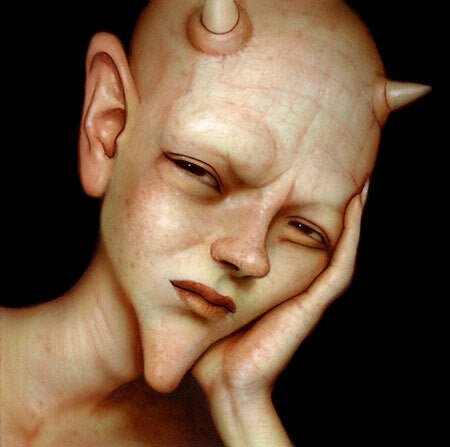
Naoto Hattori Boredom Giclee Print by Naoto Hattori
Boredom Artwork Giclee Limited Edition Surreal Print on 100% Cotton Rag Fine Art Paper by Pop Culture Graffiti Artist Naoto Hattori.
$234.00
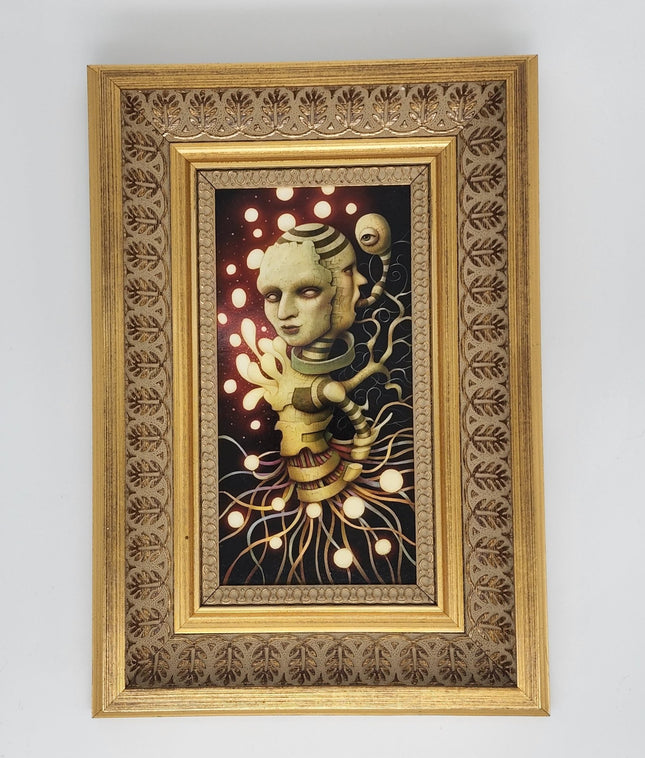
Naoto Hattori Release Original Oil Painting by Naoto Hattori
Release Original Oil Painting on Board Ornately Framed by Surreal Artist Naoto Hattori. 2011 Signed & Dated On Verso Original One of a Kind Oil Painting Framed Artwork Frame Size 9.5x13.75 Image Size 3x3 Ornate Guilded Gold Custom Frame By Artist. Release Original Oil Painting by Naoto Hattori
$3,919.00
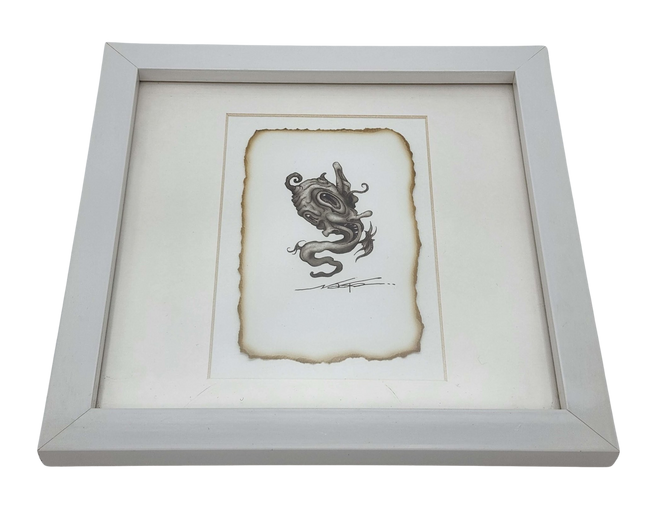
Naoto Hattori Catalyst Original Graphite Pencil Drawing by Naoto Hattori
Catalyst Original Hand Drawn Art Drawing on Framed Hand Deckled Aged Art Paper by Surreal Artist Naoto Hattori. 2012 Signed Original One-of-a-Kind Pencil/Graphite Drawing Framed Artwork Frame Size 8.5x8.5 Image Size 3x5. Custom Framed & Matted By Artist Naoto Hattori's "Catalyst": A Surreal Intersection of Imagery and Emotion "Catalyst," an original hand-drawn art piece by the surreal artist Naoto Hattori, represents a unique convergence of delicate pencil work and emotive surrealism captured on hand-deckled aged art paper. This 2012 one-of-a-kind pencil/graphite drawing is a testament to Hattori's skill in portraying complex, dream-like visions within a compact space. The framed artwork, with an image size of 3x5 inches and a frame size of 8.5x8.5 inches, has been custom framed and matted by the artist, adding a personal touch that complements the intimate scale of the work. This drawing stands apart from conventional urban art's execution and presentation. While street pop art and graffiti artwork are typically associated with large-scale, public displays, Hattori's "Catalyst" invites a more personal interaction. The piece is imbued with the intricacies of fine art while resonating with the accessibility and visceral impact often found in street art. Hattori's work does not scream from the walls; instead, it whispers, drawing the viewer into a one-on-one dialogue with the art. Exploring the Artistic Detail in "Catalyst" The meticulous detail in "Catalyst" showcases Hattori's masterful control of pencil and graphite, revealing an otherworldly creature that seems to emerge from the very fibers of the aged paper. The hand-decked paper highlights the artist's appreciation for the tactile qualities of his materials and his intent to merge the traditional with the surreal. Each stroke and shadow in the drawing contributes to an overall sense of depth and dimension, breathing life into the fantastical subject. The creature depicted combines familiar elements with the enigmatic, challenging the viewer's perception of reality. The intimate size of the image, contrasting with the more substantial frame, emphasizes the artwork's precious nature, akin to a relic or a talisman. This sense of preciousness is often sought in street pop art and graffiti artwork, where the transient nature of the medium contrasts sharply with the desire to create something lasting and impactful. Hattori's "Catalyst," while not a typical street art piece, captures the essence of what many street artists strive for—an enduring connection with the audience. Naoto Hattori's "Catalyst" is a profound piece of art that transcends the boundaries between the various disciplines of pop art, street art, and surrealism. It encapsulates the ethereal, tangible, imagined, and accurate, inviting viewers to ponder the unknown depths of their psyche. The meticulous craftsmanship, coupled with the unique presentation, makes "Catalyst" a valuable addition to contemporary art discourse, highlighting the breadth and diversity within the realm of artistic expression.
$771.00
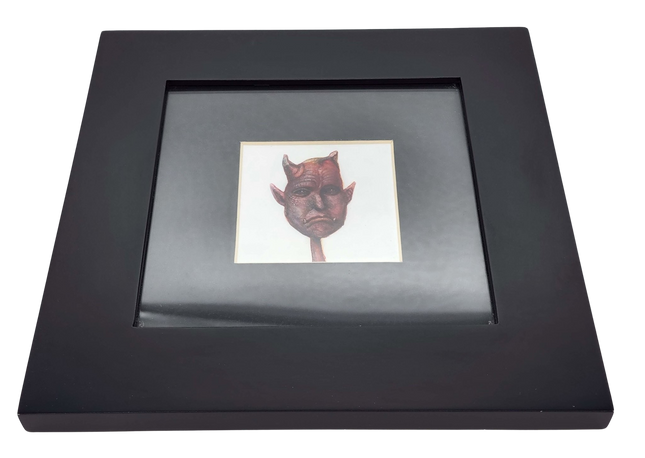
Naoto Hattori Goonie 038 Original Watercolor Painting by Naoto Hattori
Goonie 038 Original Watercolor Art Painting on Framed Fine Art Paper by Surreal Artist Naoto Hattori. 2013 Signed Original One-of-a-Kind Watercolor Painting Framed Artwork Frame Size 8.5x8.5 Image Size 3x3. Custom Framed & Matted By Artist Naoto Hattori's "Goonie 038": A Vision of Surreal Introspection "Goonie 038" by Naoto Hattori is a profound statement of surreal introspection, a masterpiece that seamlessly blends the essence of watercolor finesse with the depth of surrealistic imagination. Signed and completed in 2013, this original, one-of-a-kind painting is a testament to Hattori's commitment to the craft and his ability to evoke emotion through his art. The framed artwork, confined within an 8.5x8.5-inch boundary and showcasing a 3x3-inch image, is a microcosm of Hattori's vast artistic universe, thoughtfully custom framed and matted by the artist. The work diverges from street pop art and graffiti artwork in form and presentation yet shares an intrinsic connection with these genres through its capacity to captivate and communicate profound messages. "Goonie 038" may not adorn a public wall or shout its existence through sprawling murals, but it commands attention through its intimate scale and the powerful presence of its subject matter. Unraveling the Symbolism in "Goonie 038" In "Goonie 038," Hattori presents a creature that defies ordinary classification—a being at the intersection of human-like emotion and unbelievable features. This hybrid form is a hallmark of Hattori's style, where familiar traits are interwoven with extraordinary elements. The intricate watercolor work accentuates the textures and contours of the subject, drawing the viewer's gaze into the complexities of its expression. The creature's eyes hold a world-weariness that belies its otherworldly appearance, prompting reflection on the shared experiences that transcend the boundaries of reality. Hattori's custom framing and matting are not merely protective measures but integral components of the artwork's overall impact. The decision to frame the piece underscores the importance of context in presenting art. For Hattori, the frame is a gateway, inviting the viewer into the surreal world he has created on paper. It symbolizes the transition from the artist's mind to the viewer's world, allowing "Goonie 038" to reside within a space that honors its unique character. Naoto Hattori's "Goonie 038" is a small yet mighty representation of the artist's surreal vision, offering a window into a world that challenges and expands the viewer's perception. While it may occupy a different space than traditional street pop art and graffiti artwork, it shares the same spirit of rebellion against the ordinary and a desire to disrupt and enchant. Through "Goonie 038," Hattori has created a piece that stands as a compelling contribution to the world of surreal art, which holds the power to mesmerize and provoke thought in equal measure.
$651.00







